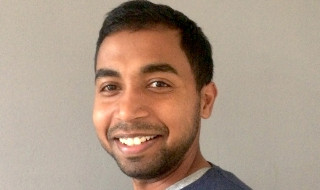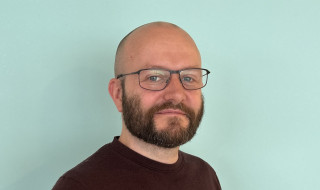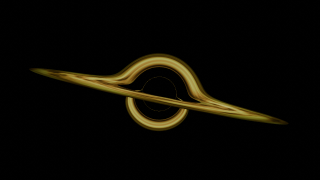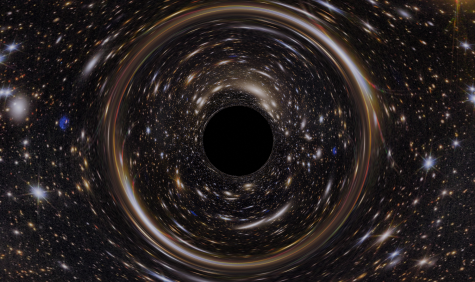"I have a passion for education"
Virtual reality lets students experience a black hole
A perfect meeting of science and visualisation is the research into black holes. Simulating and visualising black holes helps us to better understand gravity in its most extreme form. University lecturer Bijoy Bera is working with SURF's visualisation team on a VR application that lets you virtually experience this physical phenomenon.
Key facts
Who: Bijoy Bera
Position: associate professor
Organisation: TU Delft
Service: Visualisation
Challenge: Visualise a black hole in VR, to let students experience and understand the complex concepts of the general theory of relativity - this requires a lot of programming and computing power.
Solution: Accessible and open software, plus computing power and expertise from SURF.
Imagine this: you board a spaceship, fly to the edge of a black hole and look out of the window. What you see is spectacular, says Bijoy Bera, associate professor at TU Delft. "All kinds of objects and even rays of light are pulled into the black hole. The gravity of a black hole is so strong that nothing can escape from it." Of course, it is science fiction to fly to that black hole. Or is it? What if you could experience this in virtual reality?
Improving education

Bijoy Bera
"I have a passion for education," says Bera. Last year, he was even voted Educator of the Year by his students. Bera studied fluid mechanics and fluid physics, and earned his PhD on that subject at the University of Twente. "So although I come from a different branch of physics, I have always been interested in general relativity theory and black holes. During my second postdoc, in Wageningen, I started teaching a course on that topic. Since then, I’ve been trying to answer the question: how can we better understand and teach general relativity?”
Speed of light
Through experimentation, students learned more about relativity theory than through explanation, Bera observed. A few years ago, he therefore developed a virtual reality environment for undergraduate students in which a train travels at the speed of light. “They found it interesting. It also felt a bit like gaming, with the VR headset.”
After this success, Bera wanted to expand the experiment to include the general theory of relativity and black holes. "I don't know much about VR development myself, but I know very well what I want to do with it. So I have to collaborate with programmers."
"Instead of explaining the theory of relativity, it is better to have students perform an experiment"
Turning point
The film Interstellar by Christopher Nolan is praised by physicists for the way it visualises what it’s like to be near a black hole. “That film was a turning point for me: it made me start thinking seriously about this field.” The idea for the film came from renowned astrophysicist Kip Thorne, who was also an executive producer. "For the film, they put the equations of a black hole into a visualisation programme. That seemed like a good starting point to me: if I can show this not only on a screen but also in a VR environment, I have achieved my goal."
Multiple effects due to the bending of light rays can be observed in such images. For example, normally the part of the disk behind the black hole would not be visible, but now we can see both the top and the bottom of the disk - behind - the black hole.
Super difficult
Bera sent an email to Thorne, not really expecting a reply, but within a few hours he received a response. "A concise response, but with all the information I needed. He wrote: these calculations are super difficult. We have also published about it; see that and that article." Thorne did not think it would be feasible to turn it into a teaching project.
Complex physics problems
"These are some of the most difficult equations in physics; you have to be able to understand them well. I can follow them myself. But I want to visualise them so that the results don't remain abstract and can also be understood by a layperson. For that, I needed a team experienced in visualising complex physics problems. That is very expensive, mainly because of the time it takes. And you don't have that much money and time in an educational project."
Accessible and open software
A perfect meeting provided the answer when Bera visited the NWO Physics conference early this year. There, Ben de Vries, visualisation expert at SURF and himself an astronomer, gave a demo of the black hole visualisation software he had recently developed. "I heard from researchers that they need accessible and open software that makes calculations in highly curved spacetime," De Vries explained.
State-of-the-art techniques

Ben de Vries
"In Einstein's theory of gravity, light in such highly curved spacetime no longer moves in a straight line - calculating what an object looks like is then very complex. I incorporated these calculations into an open-source and easy-to-install Python package: curvedpy. For this, I implemented state-of-the-art techniques from the scientific literature in the Python programming language."
"Is this what I think it is?"
For educational purposes, De Vries then further developed curvedpy so that the tool integrates with a custom render engine he built for Blender, an open-source 3D graphics programme. A render engine, also known as a raytracer, is software that calculates how light moves through a 3D environment. The Black Hole Render Engine can do this in the highly curved spacetime of a black hole. The result: you can travel past a black hole and see for yourself what it looks like according to theory. Bera stepped up to De Vries: "Is this what I think it is?" he asked. "That's exactly what I need for my teaching!"

Black hole surrounded by a flat disk.
Black hole surrounded by a flat disk.
In the image above, the black hole is surrounded by a flat disk. Multiple effects due to the bending of light rays can be observed in such images. For example, normally the part of the disk behind the black hole would not be visible, but now we can see both the top and the bottom of the disk - behind - the black hole.
Challenges
Since then, they have been working intensively together to develop the software into a VR application that Bera can use for his master's degree. "We only met two months ago, but it feels like we have been working together for a year," says Bera. "It is not yet at the level I want, we are still very much searching and there are many challenges."
"We want students to experience real physics using VR"
Wanted: VR developer
TU Delft has its own VR lab, but it does not have enough expertise in this field. "They are mainly there to support teachers within the TU, and a black hole is not a priority for a technical university. So we are still looking for a VR developer who can implement Ben's calculations in virtual reality. Moreover, these calculations take a lot of computing power. Without SURF's computing facilities and expertise, I could never do this."
Visualisation of the sun rotating around a black hole. The bending of light rays create effects such as multiple images of the sphere (when the sphere is to the side you see a faint second image of the sphere at the other side of the black hole) as well as being able to see the sphere even when it is directly behind the black hole (the sphere is projected into an Einstein ring around the black hole).
Fantastic
So it will be at least another year before students can experience this VR experiment in lecture halls, Bera expects. After that, he wants to expand the experiment with different variations. "It would be fantastic if in five years a student can experience what it is like when you dive into a black hole," he says. However, nobody knows what the core of a black hole looks like, so that will be more speculation than simulation." With a chuckle, "In Interstellar, they did manage to do that. But our goal as educators isn’t to show people a sci-fi film; we want students to experience real physics.”
Einstein's general theory of relativity describes how gravity works: it distorts space and time around an object with mass. Black holes form when very heavy stars collapse at the end of their life cycle. When a lot of mass is compressed at a small point, it creates such a strong curvature of space and time that everything around it is sucked into it: a black hole. The gravity of a black hole is so strong that not even light can escape from it.
Text: Josje Spinhoven
Images: Ben de Vries, rendered in Blender using the Black Hole Render Engine
